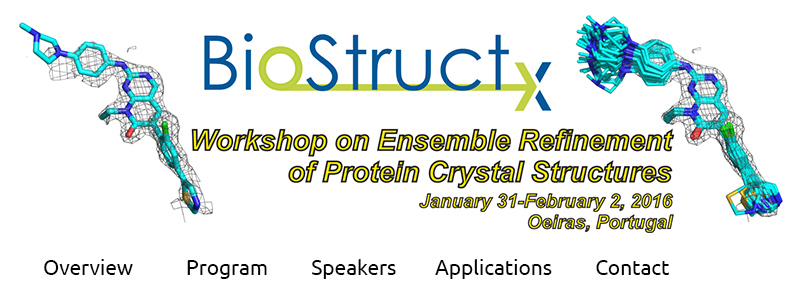Ensemble Refinement

It is well known that an X-ray crystallographic structure represents a time and space average of the molecules contained in the crystal. However, it is also accepted that single-structure models derived from X-ray data do not adequately account for the inherent, functionally important dynamics of protein molecules.
For a long time, crystallographic refinement programs were limited to producing a single “static” structural model where the inherent disorder/dynamics was modeled in two ways, at the expense in the number of refinement parameters:
- A more or less complex atomic displacement parameter model, depending on data resolution (i.e., from isotropic to TLS-anisotropic to fully anisotropic).
- Alternate conformations for parts of the structure with clearly resolved electron density.
In protein crystal structures the ADPs model atomic vibrations according to a harmonic potential energy function in addition to positional disorder between crystallographically equivalent molecules. Although in some cases it is possible to define 2 or even 3 alternate conformations for parts of the structure, it is often neither easy nor even possible to guess the alternate atomic positions of mobile side chains because of poor electron density.
New methods and tools are emerging to address these limitations of conventional refinement and one of the most interesting is the combination of molecular dynamics methods with crystallographic refinement, in what is termed Ensemble Refinement.
You are cordially invited to attend the Biostruct-X Workshop on Ensemble Refinement of Protein Crystal Structures, to be held at ITQB in Oeiras, Portugal from January 31 to February 2, 2016. The lectures dealing with the emerging theoretical and practical concepts will be combined with hands-on tutorial sessions.
This workshop is directed to PhD students and young Post-doctoral researchers who are already experienced in Macromolecular Crystallography and who wish to learn about this new paradigm of X-ray protein crystal structure refinement, towards its application in their own projects. To that effect, participants will be strongly encouraged to bring their own data to the workshop. The number of places is limited, therefore apply early!
The organizers,
Pedro Matias (ITQB and CTQB-NPS from Universidade Nova de Lisboa, Oeiras, Portugal)
Manfred Weiss (Helmholtz-Zentrum Berlin für Materialien und Energie, Berlin, Germany)







